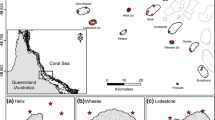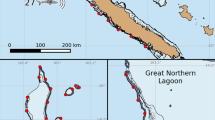Abstract
Knowledge of the spatial ecology and movement of animals contributes to our understanding of intra- and inter-specific interactions and ecosystem dynamics, and can inform conservation actions. Here we assessed the space use and activity levels of a marine predator, the Caribbean reef shark (Carcharhinus perezi), in coastal regions of Eleuthera, The Bahamas over a 60-day period using acoustic telemetry. Of the 14 adult sharks (eight males, six females) tagged with acoustic transmitters (equipped with accelerometer sensor), nine were detected in a 14 km2 gridded receiver array. Male sharks were significantly less likely to be detected over time relative to females. Given post-release survival is typically high in C. perezi, this finding may indicate that males have larger home ranges and may exhibit lower site fidelity compared to females. Patterns of space use indicated C. perezi primarily occupied the outer reef shelf and were rarely detected on the interior of the reef. Shark activity levels (inferred from acceleration profiles) were highest in close proximity to the reef shelf. Our findings indicate C. perezi individuals frequently occupy deeper water habitats, but make forays into reef shelf habitats where high activity levels are likely related to foraging.


Similar content being viewed by others
References
Ball MM, Harrison CGA, Hurley RJ, Leist CE (1969) Bathymetry in the vicinity of the northeastern scarp of the great Bahama Bank and Exuma sound. Bull Mar Sci 19:243–252
Barnett A, Payne NL, Semmens JM, Fitzpatrick R (2016) Ecotourism increases the field metabolic rate of whitetip reef sharks. Biol Conserv 199:132–136. doi:10.1016/j.biocon.2016.05.009
Brooks EJ, Sloman KA, Sims DW, Danylchuk AJ (2011) Validating the use of baited remote underwater video surveys for assessing the diversity, distribution and abundance of sharks in the Bahamas. Endanger Species Res 13:231–243. doi:10.3354/esr00331
Brooks EJ, Mandelman JW, Sloman KA, Liss S, Danylchuk AJ, Cooke SJ, Skomal GB, Phillip DP, Sims DW, Suski CD (2012) The physiological response of the Caribbean reef shark (Carcharhinus perezi) to longline capture. Comp Biochem Physiol A 162:94–100. doi:10.1016/j.cbpa.2011.04.012
Brooks EJ, Sims DW, Danylchuk AJ, Sloman KA (2013) Seasonal abundance, philopatry and demographic structure of Caribbean reef shark (Carcharhinus perezi) assemblages in the north-east Exuma sound, the Bahamas. Mar Biol 160:2535–2546. doi:10.1007/s00227-013-2246-0
Brownscombe JW, Cooke SJ, Danylchuk AJ (2017) Spatiotemporal drivers of energy expenditure in a coastal marine fish. Oecologia 183:689–699. doi:10.1007/s00442-016-3800-5
Buchholz R (2007) Behavioural biology: an effective and relevant conservation tool. Trends Ecol Evol 22:401–407. doi:10.1016/j.tree.2007.06.002
Chapman DD, Pikitch EK, Babcock E, Shivji MS (2005) Marine reserve design and evaluation using automated acoustic telemetry: a case-study involving coral reef-associated sharks in the Mesoamerican Caribbean. Mar Technol Soc J 39:42–55. doi:10.4031/002533205787521640
Chapman DD, Pikitch EK, Babcock EA, Shivji MS (2007) Deep-diving and diel changes in vertical habitat use by Caribbean reef sharks Carcharhinus perezi. Mar Ecol Prog Ser 344:271–275. doi:10.3354/meps06941
Cooke SJ, Brownscombe JW, Raby GD, Broell F, Hinch SG, Clark TD, Semmens JM (2016) Remote bioenergetics measurements in wild fish: opportunities and challenges. Comp Biochem Physiol A 202:23–37. doi:10.1016/j.cbpa.2016.03.022
Dulvy NK, Fowler SL, Musick JA, Cavanagh RD, Kyne PM, Harrison LR et al (2014) Extinction risk and conservation of the world’s sharks and rays. elife 3:e00590. doi:10.7554/eLife.00590
Ferretti F, Worm B, Britten GL, Heithaus MR, Lotze HK (2010) Patterns and ecosystem consequences of shark declines in the ocean. Ecol Lett 13:1055–1071. doi:10.1111/j.1461-0248.2010.01489.x
Garla RC, Chapman DD, Wetherbee BM, Shivji M (2006) Movement patterns of young Caribbean reef sharks, Carcharhinus perezi, at Fernando de Noronha archipelago, Brazil: the potential of marine protected areas for conservation of a nursery ground. Mar Biol 149:189–199. doi:10.1007/s00227-005-0201-4
Gjelland KØ, Hedger RD (2013) Environmental influence on transmitter detection probability in biotelemetry: developing a general model of acoustic transmission. Methods Ecol Evol 4:665-674
Gleiss AC, Gruber SH, Wilson RP (2009) Multi-channel data-logging: towards determination of behaviour and metabolic rate in free-swimming sharks. In Tagging and tracking of marine animals with electronic devices. Springer, Netherlands, p 211-228.
Gleiss AC, Dale JJ, Holland KN, Wilson RP (2010) Accelerating estimates of activity-specific metabolic rate in fishes: testing the applicability of acceleration data-loggers. J Exp Mar Biol Ecol 385:85-91
Gleiss AC, Wright S, Liebsch N, Wilson RP, Norman B (2013) Contrasting diel patterns in vertical movement and locomotor activity of whale sharks at Ningaloo reef. Mar Biol 160:2981–2992
Haas AR, Fedler T, Brooks EJ (2017) The contemporary economic value of elasmobranchs in the Bahamas: reaping the rewards of 25 years of stewardship and conservation. Biol Conserv 207:55–63. doi:10.1016/j.biocon.2017.01.007
Hammerschlag N, Gallagher AJ, Lazarre DM (2011) A review of shark satellite tagging studies. J Exp Mar Biol Ecol 398:1–8. doi:10.1016/j.jembe.2010.12.012
Hoolihan JP, Luo J, Abascal FJ, Campana SE, De Metrio G, Dewar H et al (2011) Evaluating post-release behaviour modification in large pelagic fish deployed with pop-up satellite archival tags. ICES J Mar Sci 68:880–889. doi:10.1093/icesjms/fsr024
Hussey NE, Kessel ST, Aarestrup K, Cooke SJ, Cowley PD, Fisk AT, Harcourt RG, Holland KN, Iverson SJ, Kocik JF, Flemming JEM, Whoriskey FG (2015) Aquatic animal telemetry: a panoramic window into the underwater world. Science 348:1255642. doi:10.1126/science.1255642
Kessel ST, Cooke SJ, Heupel MR, Hussey NE, Simpfendorfer CA, Vagle S, Fisk AT (2014) A review of detection range testing in aquatic passive acoustic telemetry studies. Rev Fish Biol Fish 24:199–218
Knip DM, Heupel MR, Simpfendorfer CA (2010) Sharks in nearshore environments: models, importance, and consequences. Mar Ecol Prog Ser 402:1–11. doi:10.3354/meps08498
Knip DM, Heupel MR, Simpfendorfer CA (2012) Habitat use and spatial segregation of adult spottail sharks Carcharhinus sorrah in tropical nearshore waters. J Fish Biol 80:767–784. doi:10.1111/j.1095-8649.2012.03223.x
Koenig CC, Bueno LS, Coleman FC, Cusick JA, Ellis RD, Kingon K, Locascio JV, Malinowski C, Murie DJ, Stallings CD (2017) Diel, lunar, and seasonal spawning patterns of the Atlantic goliath grouper, Epinephelus itajara, off Florida, United States. Bull Mar Sci 93:391–406. doi:10.5343/bms.2016.1013
Maljković A, Côté IM (2011) Effects of tourism-related provisioning on the trophic signatures and movement patterns of an apex predator, the Caribbean reef shark. Biol Conserv 144:859–865. doi:10.1016/j.biocon.2010.11.019
McCauley DJ, Young HS, Dunbar RB, Estes JA, Semmens BX, Micheli F (2012) Assessing the effects of large mobile predators on ecosystem connectivity. Ecol Appl 22:1711–1717. doi:10.1890/11-1653.1
Morales JM, Moorcroft PR, Matthiopoulos J, Frair JL, Kie JG, Powell RA et al (2010) Building the bridge between animal movement and population dynamics. Proc R Soc B 365:2289–2301. doi:10.1098/rstb.2010.0082
Moultrie S (2012) Master plan for the Bahamas national protected area system. The Nature Conservancy, Northern Caribbean Office, Nassau
Mucientes GR, Queiroz N, Sousa LL, Tarroso P, Sims DW (2009) Sexual segregation of pelagic sharks and the potential threat from fisheries. Biol Lett rsbl-2008. doi:10.1098/rsbl.2008.0761
Papastamatiou YP, Watanabe YY, Bradley D, Dee LE, Weng K, Lowe CG, Caselle JE (2015) Drivers of daily routines in an ectothermic marine predator: hunt warm, rest warmer? PLoS One 10:e0127807
Payne NL, Gillanders BM, Seymour RS, Webber DM, Snelling EP, Semmens JM (2011) Accelerometry estimates field metabolic rate in giant Australian cuttlefish Sepia Apama during breeding. J Anim Ecol 80:422–430. doi:10.1111/j.1365-2656.2010.01758.x
Pikitch EK, Chapman DD, Babcock EA, Shivji MS (2005) Habitat use and demographic population structure of elasmobranchs at a Caribbean atoll (Glover’s reef, Belize). Mar Ecol Prog Ser 302:187–197. doi:10.3354/meps302187
R Core Team (2013) R: a language and environment for statistical computing. R Foundation for Statistical Computing, Vienna URL http://www.R-project.org/
Roff G, Doropoulos C, Rogers A, Bozec YM, Krueck NC, Aurellado E, Priest M, Birrell C, Mumby PJ (2016) The ecological role of sharks on coral reefs. Tr Ecol Evol 31:395–407. doi:10.1016/j.tree.2016.02.014
Rosa RS, Mancini P, Caldas JP, Graham RT (2006) Carcharhinus perezi. The IUCN Red List of Threatened Species 2006 doi:https://doi.org/10.2305/IUCN.UK.2006.RLTS.T60217A12323052.en
Rollin BE, Kessel ML (1998) Guidelines for the treatment of animals in behavioural research and teaching. Anim Behav 55:251–257
Schlaff AM, Heupel MR, Simpfendorfer CA (2014) Influence of environmental factors on shark and ray movement, behaviour and habitat use: a review. Rev Fish Biol Fish 24:1089–1103. doi:10.1007/s11160-014-9364-8
Shipley ON, Howey LA, Tolentino ER, Jordan LK, Ruppert JL, Brooks EJ (2017) Horizontal and vertical movements of Caribbean reef sharks (Carcharhinus perezi): conservation implications of limited migration in a marine sanctuary. R Soc Open Sci 4:160611. doi:10.1098/rsos.160611
Sutherland WJ (1998) The importance of behavioural studies in conservation biology. Anim Behav 56:801–809. doi:10.1006/anbe.1998.0896
Tilman D, Kareiva PM (1997) Spatial ecology: the role of space in population dynamics and interspecific interactions, vol 30. Princeton University Press, Princeton
Whitney NM, Papastamatiou YP, Holland KN, Lowe CG (2007) Use of an acceleration data logger to measure diel activity patterns in captive whitetip reef sharks, Triaenodon obesus. Aquat Living Resour 20:299–305. doi:10.1051/alr:2008006
Whitney NM, Pratt HL Jr, Pratt TC, Carrier JC (2010) Identifying shark mating behaviour using three-dimensional acceleration loggers. Endanger Species Res 10:71–82. doi:10.3354/esr00247
Wilson AD, Wikelski M, Wilson RP, Cooke SJ (2015) Utility of biological sensor tags in animal conservation. Conserv Biol 29:1065-1075
Zuur A et al (2009) Mixed effects models and extensions in ecology with R. Springer Science & Business Media, New York
Acknowledgements
This project was funded by the Save Our Seas Foundation (SOSF-2009-94). The authors would like to acknowledge the Cape Eleuthera Foundation for providing project funding, and students and staff of the Cape Eleuthera Institute and Island School for invaluable field support. Permission to capture sharks within the Bahamian Shark Sanctuary was established in accordance with Bahamian Department of Marine Resources Form 20A, Regulation 36D (3), permitting fishing, possession, and exportation of sharks or shark parts (permits MAF/FIS/17 and MAF/FIS/34 issued to the Cape Eleuthera Institute). Animal sampling protocols were aligned with The UK Home Office Animals (Scientific Procedures) Act regulations, and guidelines of the Association for the study of Animal Behaviour, and Animal Behaviour Society (Rollin and Kessel 1998).
Author information
Authors and Affiliations
Corresponding author
Rights and permissions
About this article
Cite this article
Shipley, O.N., Brownscombe, J.W., Danylchuk, A.J. et al. Fine-scale movement and activity patterns of Caribbean reef sharks (Carcharhinus perezi) in the Bahamas. Environ Biol Fish 101, 1097–1104 (2018). https://doi.org/10.1007/s10641-017-0656-4
Received:
Accepted:
Published:
Issue Date:
DOI: https://doi.org/10.1007/s10641-017-0656-4




